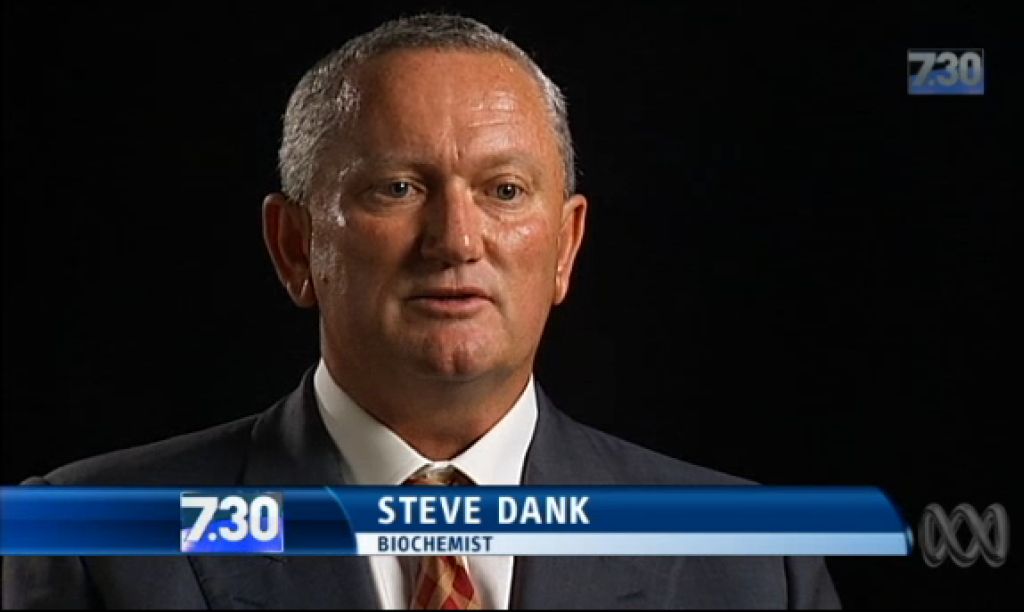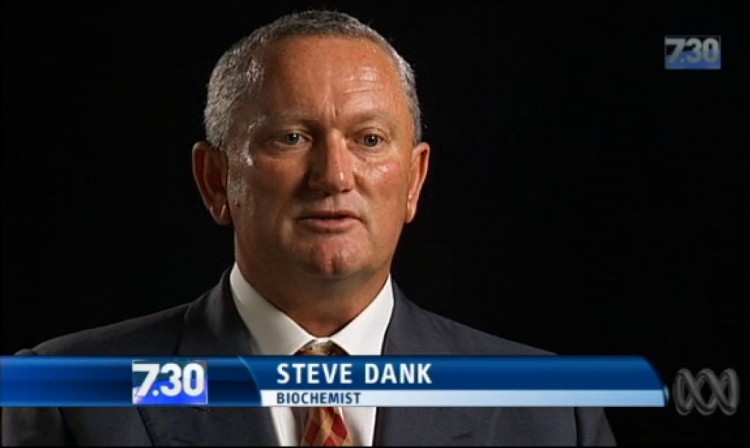
The local media has portrayed sports scientist Steve Dank as the villain in an emerging doping scandal in Australia. They identified Steve Dank as the target of the investigation after the Australian Crime Commission (ACC) suggested that the use of “peptides” was widespread in various professional sports. Media reports have vilified Dank as “The Pharmacist” and “The Peptide King.” But has the media been premature in their rush to judgment?
The proverbial “smoking gun” has yet to make an appearance. The conclusion that Dank is the man behind the suspected peptide scandal has been based on two potentially incriminating associations.
Steve Dank’s Connection to Peptides and Professional Athletes
First, the Australian Sports Anti-Doping Authority (ASADA) announced the launch of an investigation into the Essendon Football Club related to the use of peptides. Dank was the sports scientist in charge of the team’s supplementation protocol during the period in question. In addition, Dank had worked with several other teams in the Australian Football League (AFL) as well as the National Rugby League (NRL).
Secondly, Dank is one of the four co-directors of the Medical Rejuvenation Clinic (MRC). MRC offers several “legal peptides” for sale on its website. These peptides include IGF-1, MGF, GHRP-2, GHRP-6, CJC-1295, Hexarelin and AOD-9604.
Are Peptides Banned by WADA?
Only IGF-1 and MGF are explicitly banned by the World Anti-Doping Agency (WADA) in its 2013 List of Prohibited Substances and Methods.
However, GHRP-2, GHRP-6, CJC-1295, Hexarelin and AOD-9604 are all presumably banned under the catch-all terminology used by WADA under the “Peptide Hormones, Growth Factors and Related Substances” section.
The extremely broad catch-all prohibits the following generic substances:
“[A]ny other growth factor affecting muscle, tendon or ligament protein synthesis/degradation, vascularisation, energy utilization, regenerative capacity or fibre type switching and other substances with similar chemical structure or similar biological effect(s).”
Steve Dank as ‘Scapegoat’ and ‘Sacrificial Lamb’
Gregory Stanton, an attorney for Dank, declared that Dank was nothing more than a scapegoat.
“He stands, if I may use the phrase, as a sacrificial lamb on the altar of sport which this country worships and adores on a day-to-day basis…” Stanton said. “There is a degree of innuendo, rumour, scuttlebutt and tenuous information floating around, none of which is very specific at all. In the face of that, he says, ‘I’ve done nothing wrong’. He is the scapegoat – that’s how we see it.”
Stanton vehemently denied that his client provided any prohibited substance to any professional athlete(s) who participated in a WADA-compliant sport(s).
Dank’s attorneys have threatened to file a $10 million lawsuit against media outlets for defamation, injurious falsehood and financial loss arising out of “false allegations in the media that the plaintiffs have sold illegal drugs to sportspeople.”
Steve Dank Provides Different Peptides to Players and Coaches
Steve Dank finally broke his silence in an exclusive interview with Caro Meldrum-Hanna of the Australian Broadcasting Corporation (ABC) on February 11, 2013.
Dank repeatedly denied injecting any Essendon players with any substance prohibited by WADA. He admitted only to providing intravenous injections of vitamin B and vitamin C to some players. But nothing else via intravenous injection.
Dank denied providing intravenous administration of peptides. But he did not categorically deny the application of peptides via other means. Most of the prohibited peptides are traditionally delivered via intramuscular injection.
Dank was somewhat evasive when discussing the specific peptides and their method of administration.
“Um, well, look, to be honest, the peptides themselves is a fairly broad term,” Dank said. “Even within the protein powders themselves, there could’ve been anywhere from maybe three to four different peptides that were part of the ingredients. I mean, by definition a peptide is anything that strings more than two amino acids together, so, certainly a lot of these formulations would’ve had various amount of peptides within their formulation. But again, all very, very legal and certainly all within the constraints of WADA.
Dank denied any administration of illegal supplements to players that would have been considered a breach of WADA’s rules. Dank specifically denied providing GHRP-6 to players.
At the same time, Dank admitted providing supplements that were “a little bit outside the WADA code” to some Essendon coaches and staff.
“Um, look, to be perfectly honest, there were a couple of coaches that were using some of supplements, if you like, that were a little bit outside the WADA code,” Dank said. “But again, they were entitled to it and certainly nothing illegal there.”
Dank referred to the fact that the WADA code prevents athletes from using certain drugs whose use is freely and legally permitted by individuals who are not involved in WADA-sanctioned sports competition.
Dank’s Involvement with Anti-Aging Clinic Distinct from Role as Athletic Consultant
Dank also acknowledged his involvement in the “anti-aging” and “rejuvenation” space in his interview with Meldrum-Hanna of ABC. But denied the suggestion that any athletes were treated by his clinics.
Dank’s clinics did sell peptides. The peptides, while legal for non-athletes, are banned by the WADA code.
“Well they’re peptides, they’re legal peptides,” Dank said. “So basically most of the peptides are orientated towards sorta enhancing growth hormone release. There’s another peptide which is orientated towards improving the efficacy of testosterone, so it’s not actually supplementing testosterone with the use of testosterone, but improves testosterone efficiency.”
Dank recognized the suspicion that his role at the Medical Rejuvenation Clinic could cast on his role as a consultant for professional sports teams. He maintained that the two roles operated as distinct entities.
“Well it’s probably only a curious link because I happen to be working at Essendon and of course my other business interests happen to be selling it,” Dank said. “But, to be honest, that’s no different to a situation where a club doctor in his medical bag will carry certain things which of course would be prohibited in a sporting setting, but they can obviously use it in a therapeutic setting. So of course it’s a fairly easy association to be made, but, you know, under no circumstances was GHRP-6 ever used at Essendon.
Defenders of Steve Dank
Doctor Robin Willcourt, the owner of Epigenx Integrated Medicine, reported that Dank and Dean Robinson discussed the Essendon Bombers’ supplement protocol in detail with him. Willcourt said all supplement were WADA-compliant. The most controversial supplement was colostrum.
”He [Dank] was talking about all the supplements they were taking. By the way, none of them were illegal. He was talking about bovine colostrum and amino acids and various combinations to make protein shakes, all that sort of stuff.”
WADA has not prohibited colostrum although it has advised against its use:
“Colostrum is not prohibited per se, however it contains certain quantities of IGF-1 and other growth factors which are prohibited and can influence the outcome of anti-doping tests. Therefore WADA does not recommend the ingestion of this product.”
Willcourt claimed Dank and Robinson were concerned about ensuring that all potential protocols were WADA-compliant.
”We had a discussion about what we could or couldn’t do and one of the things that we couldn’t do was use peptides, we couldn’t do testosterone, we couldn’t do growth hormone, and there was a lot of hand-wringing going on about how we could make these guys healthy without violating the rules.”
Tony Doherty, the owner of Doherty’s Gyms and IFBB bodybuilding promoter, defended Dank when contacted by ABC.
“I know Steve Dank fairly well. I rate him as a very intelligent fellow and I doubt very much he’d be giving anything illegal to football players. And he wouldn’t jeopardise the careers of the players, the integrity of the AFL or the reputation of the Essendon Football Club…
“The media’s heard the word “intravenous” and they’ve heard the word “injection” and they’ve gone into an absolute frenzy. It doesn’t mean that everything that’s injected or taken intravenously is illegal or banned by sporting organisations.”
Did Steve Dank Provide Peptides to Pro Athletes?
The villainization of Steve Dank highlights an important and confusing issue surrounding the WADA List of Prohibited Substances and Methods.
The WADA code ONLY applies to athletes in WADA-sanctioned sports. It does not apply to the general population.
Just because an athlete is forbidden to use certain performance- and image-enhancing drugs (PIEDs) doesn’t necessarily mean ordinary, responsible and law-abiding adults are not legally permitted to use these substances to feel better, to increase their muscle size and strength, to reduce bodyfat and/or to enhance their physical attractiveness.
Non-athletes have much more freedom in their choice of supplements than professional athletes. Their supplement use is not, nor should it be, governed by the moral authority of WADA.
Any performance expert who works with both the general population and WADA athletes recognizes the different rules that apply to each group.
Dank obviously has access, knowledge and experience with peptides such as IGF-1, MGF, GHRP-2, GHRP-6, CJC-1295, Hexarelin and AOD-9604.
Is it possible that Dank only sold these peptides to NON-ATHLETES while wearing the hat of the Medical Rejuvenation Clinic and provide only WADA-compliant supplements to ATHTETES while wearing the hat of a team sports scientist?
Certainly.
Given that most of the prohibited peptides are undetectable under current anti-doping protocols, is it possible that Dank thought he could get away with administering banned peptides to athletes?
Certainly.
At this point, it appears that there is only suspicion, however justified it might be, that Dank could have given prohibited peptides to players due to his multiple professional endeavors.
It should be noted that the proverbial “smoking gun” has yet to emerge.
The Australian Crime Commission has refused to identify the individual(s) suspected of distributing peptides nor provided any evidence or testimony to support the allegations. Ironically, the ACC defended its position citing the protection of persons against reputational damage and the right to a fair trial under Section 60 of the Australian Crime Commission Act 2002.
The Australian Crime Commission can not name clubs and individuals, as they are protected under Section 60 of the Australian Crime Commission Act 2002 which protects the rights of persons against reputational damage and the right to a fair trial..
Not a single coach or player has publicly alleged that Dank provided athletes with IGF-1, MGF, GHRP-2, GHRP-6, CJC-1295, Hexarelin or AOD-9604.
The most damning information to publicly emerge is that players and coaches allegedly did not know what Dank was giving them.
In the current climate of anti-doping hysteria, the only thing that we can be sure of is that a witch-hunt will find its witches.

About the author
Millard writes about anabolic steroids and performance enhancing drugs and their use and impact in sport and society. He discusses the medical and non-medical uses of anabolic-androgenic steroids while advocating a harm reduction approach to steroid education.

Leave a Reply
You must be logged in to post a comment.